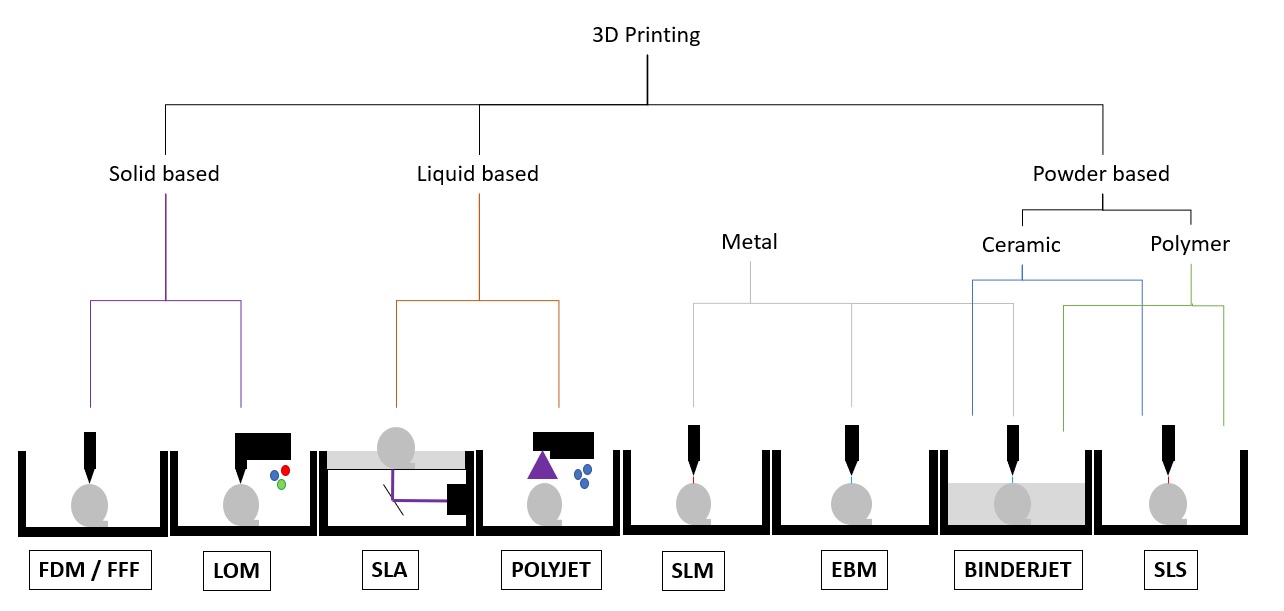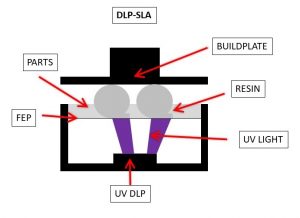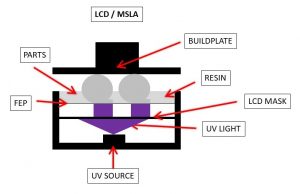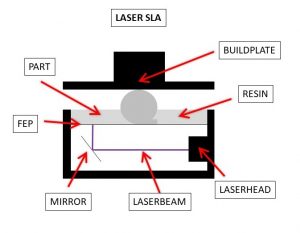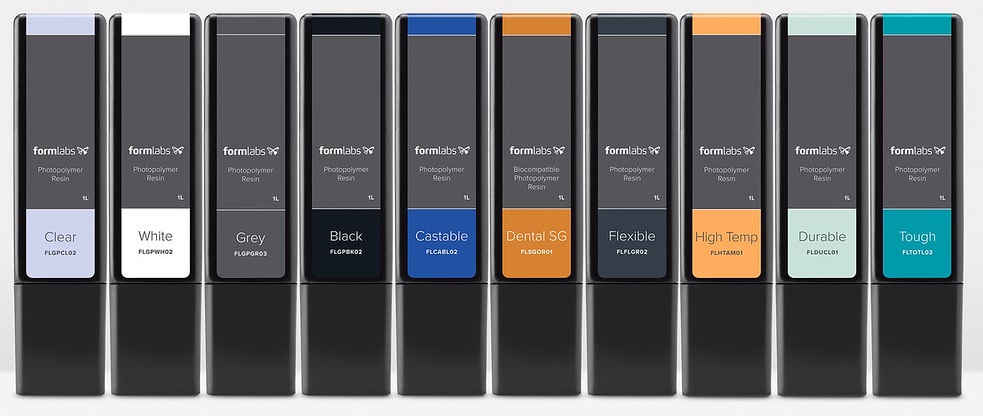In this blog I am looking to pull together multiple resources in a condensed way to provide an overview of 3D printing technologies and materials. Sources are sited in-line.
An overview of the common types of 3d printing technology by feedstock type.
Plastic:
FDM – Fused Deposition Modelling is a proprietary technology of Stratasys, Ltd. FDM Technology works with specialized 3D printers and production-grade thermoplastics to build strong, durable and dimensionally stable parts with the best accuracy and repeatability of any 3D printing technology.
Stratasys founder Scott Crump invented FDM Technology more than 20 years ago, and Stratasys has continued to lead the 3D printing revolution ever since. [1] Fused Deposition Modeling 3D Printing Technology – Stratasys – Stratasys
A typical FDM machine consists of an extrusion-nozzle assembly, a build platform, and a material in the form of a filament. The filament material enters the extruder where it is heated to a temperature of about 320˚C. This extruder melts the material and selectively deposits it onto the build platform through a nozzle attached at the end of it. The entire process is isolated from the ambient environment. The print chamber is maintained at around 90˚C. As a result, the filament flows from a hot extruder through a heated environment onto a build platform which is hot too, since it is situated in the print chamber. This hot-hot-hot transition leads to better control on the mechanical properties of the part being printed. [2] FFF Is Not FDM | Don’t Be Fooled By Amateurs | Experts View (truventor.ai)
FFF – Fused Filament Fabrication shares the same basic process architecture as FDM, however the part output and quality is different. FDM is an industrial grade technology whereas FFF is a hobbyist level 3D Printing technology. FDM caters to part applications requiring high quality, engineering-grade prototypes that can withstand mechanical loads. Whereas FFF caters to part applications requiring prototypes for form and visual validation. [2]FFF Is Not FDM | Don’t Be Fooled By Amateurs | Experts View (truventor.ai)
Key takeaway : FDM and FFF are very similar, but not the same.
Types of material:
PLA: Polylactic acid. High strength, low flexibility, not usually good for food safety
ABS: Acrylonitrile butadiene styrene. High strength, medium flexibility, not good for food safety
PET: Polyethylene terephthalate. High strength, medium flexibility, not usually good for food safety
TPU: Theromoplastic polyurethane. Medium strength, very high flexibility, not good for food safety
Nylon: High strength, High flexibility, not usually good for food safety
PC: Polycarbonte. Very High strength, Medium Flexibility, not usually good for food safety
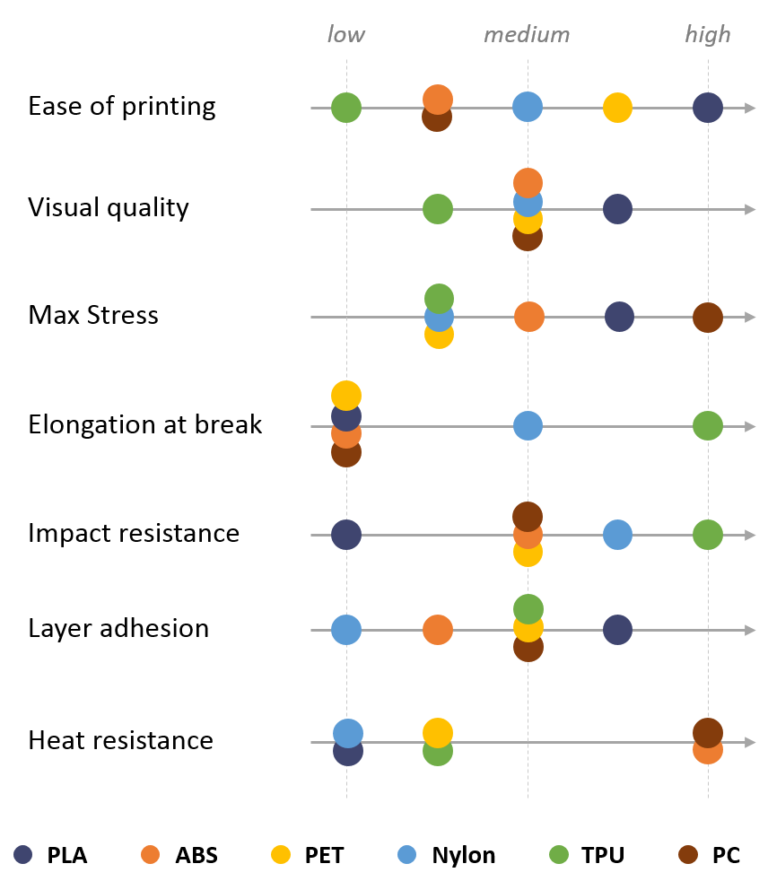
[3] FDM 3D printing materials compared | Hubs
Wood and Metal filled plastics are available and are usually used for their appearance, rather than their strength or flexibility.
Resin:
These three resin printing technologies produce top-quality 3D parts with liquid-based resin. The resin liquid pools in a tank over a thin film, and a light source situated below the tank is used to partially cure the resin solid.
SLA stands for Stereolithography. A laser light source is positioned to cure the resin where the beam spot meets the resin.
DLP stands for Digital Light Processing; A DLP projector casts an image onto the bottom of the resin tank.
LCD stands for Liquid Crystal Display. An LCD is used to cast or mask light to project an image onto the bottom of the resin tank.
Types of material and costs. The type of resin is photopolymer resin, which can be cured by UV light. Resin comes in different grades from smooth, to durable, flexible, ceramic filled and dental.
Key takeaway : SLA is by far, the slowest type of Resin 3D printer.
Formlabs is a leading supplier of 3d printers, here are some of the resins they offer.
Check each printer manufacturer for each of their own supported resins.
[4] Formlabs 3D Printing Materials Library
Metal:
Metal processes are split between powder bed processes and additive processes.
– Powder bed: SLM/SLS, DML, LMF, EBM
Powder-bed has synergies with SLA resin printing. A thin layer of powder is applied to the bed of the machine and a laser / electron beam cuts the desired shapes for each given layer.
SLM/SLS/LMF stands for Selective Laser Melting / Selective Laser Sintering / Laser Metal Fusion. The printing space is nitrogenous and pre-heated to about the melting point of the material. A laser is used to melt or sinter the material in place.
EBM stands for Electron Beam Melting. This is similar to the above but is done in a vacuum and using an electron beam.
– Additive: LMD, DED, DMD, Laser Cladding, MPA
LMD stands for Laser Metal Deposition but have also been referred to as DED and DMD. In this printing technology the metal powder is sprayed into a protective gas stream and melted by the laser.
Binder Jetting A liquid binder is selectively applied to join powder particles (rather than melted by lasers). This is done layer by layer. Unused powder is recycles. This process also works for ceramics. Parts are post-processed with sintering, infiltration and polishing as required.
[5] https://amfg.ai/2019/07/03/metal-binder-jetting-all-you-need-to-know
MPA stands for Metal Powder Application and does not use lasers. Powder is carried by a carrier gas and impacts the bed / previous layers at high pressure and high temperature fusing the layers together.
Metal Extrusion is heading for the hobbyist world and operates like a FFF printer were metal filament is heated and extruded down onto a bed.
[6] https://www.spotlightmetal.com/methods-of-3d-metal-printing-a-679124/
Ceramic
SLA / DLP printers use ceramic infused resin printers can print ceramic parts, these are not therefore true ceramic parts.
SLS / SLM powder based printers can also print true ceramics.
Slurry-based ceramic 3D printing technologies generally involve liquid or semi-liquid systems dispersed with fine ceramic particles
TPP stands for two-photon polymerisation. Polymerisation of the feed material is achieved by simultaneous absorption of two photons of (780 nm) or green (515 nm) lasers focussed on photosensitive resin
IJP is an evolution of 2D paper printing. Thermal excitation or the piezo-electric effect is used to control a drop of ink down onto a surface. This technique can be used to create 3d structures using ceramic inks. Parts need to be dried and sintered.
DIW direct ink writing (also known as robocasting) the extrusion method is used where viscous paste / filament directly write the structure. It is conceptually not so different to FFF printing. The part needs to go through debinding / sintering.
[7] https://www.sciencedirect.com/science/article/pii/S0955221918306782
Pottery
FFF and DLP type printers exist for pottery printing. With FFF clay printers, the extruder part of the printer is a bit different where a huge syringe holds the clay and a plunger pushes is into the nozzle. These parts will need to be fired in a kiln.
[8] https://all3dp.com/2/ceramic-3d-printer-ceramic-3d-printing/
The potterbot and delta WASP printers look very cool.
[9] https://shop3duniverse.com/products/3d-potterbot-10-pro#v32181970337846
[10] https://www.3dwasp.com/en/ceramic-3d-printer-delta-wasp-40100-clay/
I hope to update this blog post with new technologies and some resources on 3d printed buildings.
MORE TO COME

